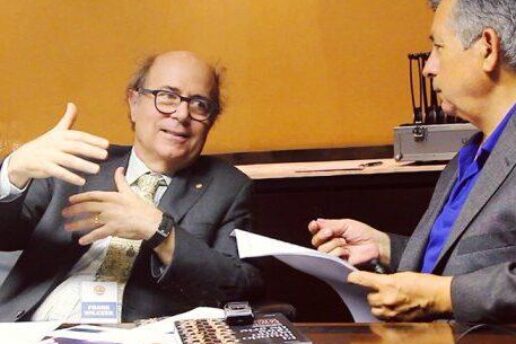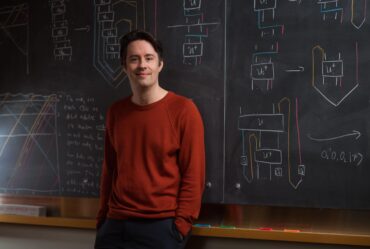
‘Physicists Have Always Been Philosophers’: In Conversation With Frank Wilczek
The Nobel Prize-winning physicist discusses free will, time travel, and the relationship between innovation and scientific discovery.
Today’s scientific landscape teems with conversations and interactions between scientists and humanists. The cutting edge of new knowledge is the product of collaboration across traditional disciplinary boundaries; it emerges, I believe, from places where researchers from diverse backgrounds come together to solve concrete problems.
This is the premise that sparked the idea for my book “Is the Universe a Hologram? Scientists Answer the Most Provocative Questions,” which comprises a series of interconnected dialogues with leading scientists who are asked to reflect on key questions and concepts about the physical world, technology, and the mind. These thinkers offer both specific observations and broader comments about the intellectual traditions that inform these questions; in doing so, they reveal a rich seam of interacting ideas.
When the book went to press a few years ago, I hadn’t yet had a chance to sit down with Frank Wilczek, the Nobel Prize-winning physicist whose work I’ve long admired. Our conversation — which took place in 2020 during his visit to the city of Valencia, Spain, as a member of the jury of the prestigious Rei Jaume I Awards — made its way into the recently published Spanish edition of the book titled “De neuronas a galaxias” (From neurons to galaxies). I’m so pleased to share our discussion, translated and edited for length, below.
Adolfo Plasencia: Professor Wilczek, let’s jump right into a difficult but, I think, fascinating subject. In my dialogue with the physicist Ignacio Cirac, a pioneer in the field of quantum computing, he said that quantum physics in a way takes into account free will. It’s a bold statement, and I’ve been eager to get your take on it. Do you agree with Cirac?
Frank Wilczek: I think the question can be understood in two different ways. So let me answer each of them separately.
The first interpretation is to ask whether quantum mechanics explains the phenomenon of free will, or whether there is something else that must be taken into account in our description of the world which is not within the scope of quantum mechanics or which is not within physics as we understand it. And the answer is that we don’t really know for sure. But there seems to be a very good hypothesis that I think scientists are in fact adopting, and it is that the phenomena of mental life, including free will, can be derived from the physical embodiment of mind in matter. So what we call “emergent” phenomena are qualitatively different behaviors that can be very difficult to see in the basic laws but can emerge in large systems with many components that have a rich structure. So, for example, when neurobiologists study the nervous system, when they study the brain, they adopt the working hypothesis that thought, memory — all mental phenomena — have a physical basis, have a physical correlate.
Another aspect is that you can ask yourself if, when we do physical experiments, we have to add something else that is mental. Do we have to make corrections for what people are thinking? Physicists now do very refined, precise, delicate experiments in which corrections have to be made for all sorts of things. You have to make corrections for trucks that pass by, you have to make corrections for electric and magnetic fields, you have to control the temperature very precisely, and so on, but something that people have never needed before is to make corrections related to what people are thinking. So I think there is very good circumstantial evidence that the world, the physical world, is not influenced by a separate mental world.
“I believe that the barriers that physicists are encountering are not barriers of principle, but barriers of technique.”
Frank Wilczek
The second interpretation of the question is whether in the formulation of quantum mechanics one should involve the observer as a separate object that has free will, that decides what to observe. Quantum mechanics has an unusual mechanism since the theory has equations, and to interpret the equations one must make an observation. I believe that, eventually, in order to understand the phenomena of free will on a physical basis, and thus fully understand quantum mechanics, we will need to understand that we have that model of consciousness that corresponds to our experience of everyday life, which is fully based on quantum mechanics. At present, I don’t think we have that. However, I believe that the barriers that physicists are encountering are not barriers of principle, but barriers of technique.
We are not advanced enough in quantum mechanics to make models where we can identify something we’d begin to recognize as consciousness. That’s a big challenge for the future. But we have every reason to believe that this challenge can one day be met. So what we need is a model that’s fully quantum mechanical and contains complicated objects that you can point to and say, that’s behaving like a conscious mind and that thing is something I can recognize as a thinking entity. Part of the trouble, of course, is that the definition of “consciousness” is very slippery.
AP: Your response reminds me of something someone quipped to me after seeing the table of contents of my book and reading the discussion with Cirac: “So physicists are now getting into philosophy too?”
FW: Physicists have always been philosophers. In fact, historically, the beginnings of philosophy and of natural science, in ancient Greece, involved the same set of people. People like Pythagoras and Thales and Plato did not consider themselves philosophers or physicists, they were both. They developed the main issues of both disciplines, somehow, together, from the very beginning. Now, in recent years physics has become much more sophisticated and has become separated from academic philosophy, which is a discipline in itself, has its own techniques and body of academic literature, and so forth.
However, I don’t think physicists should give up the enterprise of attempting to understand the world fully. They have made many advances in understanding the physical world, with precision, accuracy, and great depth, and I don’t think this disqualifies them from addressing the classic questions of philosophy. On the contrary, I think that empowers them so that they can bring in new kinds of insights into what have become the traditional “philosophical” questions.
And I think many physicists have not wanted to do that, either because they are busy with physics or because they don’t dare, but I think it is perfectly appropriate for physicists to also be philosophers. In fact, I think they should be, because many of the ideas we’ve learned about the physical world in physics are very surprising things that you wouldn’t guess from everyday experience — so I think we have things to teach philosophers. Especially since quantum mechanics is really a vast expansion of what we mean by reality, and it requires adjusting how you think. If you want to be a serious student of reality or of mind you really should know quantum mechanics. To me, a philosopher who doesn’t know quantum mechanics is like a swimmer with his or her hands tied behind their back.
“To me, a philosopher who doesn’t know quantum mechanics is like a swimmer with his or her hands tied behind their back.”
frank Wilczek
AP: Let’s move into what I’ll call the “weird ideas” questions — stuff I’ve been wondering about, as a non-scientist, coming from a position of great ignorance but with deep curiosity. If there’s any known symbol or idea about quantum physics that for ordinary people clashes with everyday logic, that’s the subject of Schrödinger’s cat. Don’t you think it’s difficult to explain to people that, not knowing if the cat is dead or alive, when you try to find out, you come to the conclusion that the cat is both dead and alive at the same time? That is something rather strange, counterintuitive, even to university students who study the subject.
FW: There are many situations when you describe them by probability that you don’t know before you observe what you will observe. That, almost by definition, is what probability means. You don’t know what you can find when you look into it, when you make the observation, when you pick from a sample, or whatever, but the quantum mechanical situation is a little bit different. What makes it paradoxical is that there is a very real sense in which the cat’s alive state and dead state possibilities coexist in a way that is not true in classical situations. Now, this coexistence is not a practical situation for cats, but we can talk about a similar situation for atoms, and it does become practical for atoms. But, in the spirit of your question, let me go back to talking about cats.
In principle let’s assume that after some time T, the probability of having a cat alive or the probability of having a cat dead, according to quantum mechanics, is predicted to be 50/50, so each of them is equally likely. We have that situation, and we can check it and experiment, so we have a lot of cats, and we can do the same experiment over and over again. But quantum mechanics tells you that if you do certain operations after that time T you can reverse the situation so that the cat will be certainly alive or that the cat will be certainly dead and both of those possibilities were present and you could restore them by doing different things to the initial situation, to the initial wave function.
So what is different about quantum mechanics, is that those two possibilities are not mutually exclusive, they both coexist in the situation and what happens when you observe is you find out what’s called “collapse of the wave function.” You fix one possibility, but before you made the observation, before you intervened in the situation, both were present. And if you don’t intervene, but let the systems stay close, don’t observe it, manipulate it with some fields, never looking in to know if the cat is alive or dead, you can reverse the evolution and make it totally alive or you can make it totally dead. For real cats this is not practical at all, but it is for atoms … If you are not talking about a live cat or a dead cat but about the spin of an atom, pointing up or down, you can literally do these things — you can create a situation where there is a 50/50 percent chance that the spin is up or the spin is down, but then, by operating on that wave function, without observing, just operating on it, you can show that either possibility was really present.
AP: So you believe that quantum superposition is part of human logic …
FW: Oh, yes! Well, some human beings do physics and quantum mechanics pretty successfully. You know, I do quantum mechanics sometimes and I make mistakes occasionally, but I’ve always been able to correct them. There is no real doubt about how you apply quantum mechanics to physical situations; there are right and wrong answers. It can be hard to think about — there are sometimes very counterintuitive aspects of quantum mechanics. You have to sort of take yourself outside the realm of common sense and think about some things differently, because if you did apply “common sense” you would get the wrong answer. Sometimes, it is only necessary to follow the equations. But you know, there are many people who practice quantum mechanics very successfully and use it in design of computers and all kinds of other strange gadgets, use it to do very many concrete things. It is certainly not beyond human comprehension.
“You have to sort of take yourself outside the realm of common sense and think about some things differently, because if you did apply ‘common sense’ you would get the wrong answer.”
frank wilczek
AP: All right, let’s move on to the next issue: time travel. An article you published in Quanta magazine some time ago digs into the concept of the arrow of time, which was coined by Arthur Eddington almost 100 years ago but remains an unsolved problem of modern physics. This idea postulates the “one-way direction” or “asymmetry” of time. Let me just ask you directly: Why does time travel only work in science fiction, and therefore in the imagination, and not in our everyday reality?
FW: Well, this is a very complex question. Not only in content but also in formulation. So, let me try to boil your question down to essentials. One aspect is, what do physicists mean when they talk about a universal symmetry? Since you can’t actually reverse [in the reality in which we live] the direction of time it sounds like metaphysics to say: Okay, if we reverse the direction of time, such and such and such will happen.
But, actually, it means something very concrete. It means if you have a physical situation where particles are moving with certain velocities, so at some initial moment you know where they are and what direction they are moving — these are based on certain equations — you can also discuss the situation where you struck with particles in the same space but moving in the opposite direction. So that if you change (in the equations) the direction of time, they would be moving in the opposite direction instead. You can see whether those two situations are governed by exactly the same equations.
Time reversal symmetry simply says that if you reverse the directions of rotation and the speeds of everything in your system, you will see that it is based on the same equations as if you did not. So that is what time reversal means very concretely for physicists. There are many details that are more complicated, that have to do with the spin and have to do with exotic kinds of particles. But that’s the idea. And, we find in physics that that principle works very, very accurately. Not perfectly but very, very accurately. But in everyday life it doesn’t seem that way. It doesn’t seem that the direction of time forwards and backwards is experienced in the same way in our lives. Of course, it definitively isn’t.
So, how is that consistent with the experiment I mentioned? Well, first of all, we cannot, as a practical matter, in any complicated system, let alone a human body, change the direction that every particle is moving. So you can’t really do it, in practice. You can’t get the direct consequence of the underlying time-reversal symmetry. The past and the future are very different and there is a long story about why that is, even though the basic equations look the same forwards and backwards. And I don’t think it’s appropriate to get into that whole story now, but let me say something. The essence of it is that, in the beginning, at the very early stage of the universe, the universe was much hotter and denser and was expanding. That was the Big Bang. And the Big Bang was in the past, not in the future. So that tells you that things were very different in the past and that we are heading toward a future that is very different from the origin (of the universe). And by a long series of arguments about the formation of structure and the universe cooling down and so on, you can sketch a history of the universe that makes sense and accords with our experience of time going in only one direction, although in the fundamental equations, we would have the same behavior if it moved in the opposite direction.
AP: Whew, all right. Sci-fi writers beware …
FW: I mean, it is a very intriguing possibility in principle — that of reversing the direction of the motion of particles and getting them to reverse their evolution in time so that they reconstitute their state at an earlier time. Maybe if we did that for some key molecules, to reverse aging, for example. But in practice, we don’t know what, if any, key elements we need to reverse, and so, the time-reversal symmetry of the fundamental laws does not help us in anything that is very practical for us.
AP: Finally, I want to ask you about something important to me, but not explicitly related to physics. I write and publish a lot about innovation, which has been a buzzword for decades and seems to still be. Everyone these days, from entrepreneurs to politicians, has to innovate. How do you view this term, its notion, and its meaning today, from your point of view as a scientist, but also just as a citizen? What differences do you see between the concepts of discovery, invention, and innovation in the world we live in now?
FW: I think we live in a very special time now, because of the means of communication and the aids to thinking that we have — electronics and microelectronics and computer technology and telecommunication. With all these things, people can exchange ideas much more efficiently. People can get together and think. And on the other hand, there is more to think about because the technology is very powerful and we understand matter very, very well. So we can design things based on imagination and planning and be sure that they work or at least be pretty confident that they will work. So that’s innovation — kind of exploding our knowledge of the world in order to make improvements here and there. And, to me, as a physicist, I am very proud that so much innovation has emerged from a profound understanding of the physical world and reality, that was provided originally by people who were just curious about how the physical world works, and in particular, the quantum world that we were talking about.
All microelectronics, transistors, semiconductors, etc. wouldn’t exist without a profound understanding of matter that physics produced during the 20th century. And this isn’t over yet. We understand, but we have not exhausted the potential that’s been opened up by this profound understanding of the world. In fact, the theory itself tells us that there is much more room for improvement. Richard Feynman, one of my heroes, gave a famous talk in 1959 called “There’s plenty of room in the bottom,” which anticipated the richness of the micro-world: There are many, many, many atoms in even small things. And if you can work skillfully with them, you can do little machines, you can do useful things, in medicine, and in computing, of course. In principle, he foresaw this would open up various possibilities in many directions; of course he couldn’t predict the details but he pointed in that direction. And now we see them embodied in microelectronics, nanotechnology, and modern telecommunications. All these things come from understanding this microcosmic world really well, in great detail and depth. A recent Nobel Prize in Chemistry was awarded for building molecules that function as motors and understanding how to do that. So, in many ways, this fundamental science is opening up new possibilities for innovation.
Now, you asked me about the relationship between innovation and scientific discovery. I think they kind of shade into each other. But basically science, curiosity-driven basic science is more long-term. It doesn’t focus on goals that you know how to reach, and you just want to reach them quickly or efficiently. It takes us into unknown territory, where we don’t know what we’re doing — or why we’re doing it. But that kind of thing provides new possibilities for innovation later. So I would say that scientific research is continuous with innovation, it is a long-term curiosity-driven enterprise. While short-term innovation harvests the fruit of discovery.
Adolfo Plasencia is a writer and columnist who covers science and technology, and the author of “Is the Universe a Hologram? Scientists Answer the Most Provocative Questions.”


